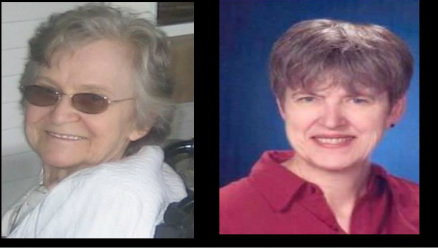Josephine Paterson & Loretta Zderad
Humanistic Nursing Theory: Paterson & Zderad

Josephine Paterson & Loretta Zderad
Background
Josephine Paterson and Loretta
Zderad earned first diplomas in nursing, then Bachelor's degrees in Nursing
education before continuing to graduate programs. Their career as nursing
academics got started in the 1950s, when they were both employed at Catholic
University where they met. They continued to work together and remained friends
for the next 40 years. They later continued onto their doctorate degrees in the
1960s.
While pursuing their doctorate
degrees, they found that they had difficulty communicating their experiential
view of nursing, and wanted to do so through a positivistic, scientific nursing
theory approach. With this goal in mind, they began combining their knowledge
of nursing and nursing theory with existential and phenomenological
philosophies that they were both interested in. Through this addition of
phenomenological philosophy applied to nursing, they believed they could
articulate their process and personal theories of nursing.
By 1971, they had begun to
define their theory and what it was that made it unique as an approach to
nursing. They then began to research other nurse's experience, and used their
theory as a perspective and method for nurses to examine their experiences.
Through this, their goal was to develop it into theoretical propositions, which
could serve as guides for nursing practitioners.
Key concept
- Humanistic
nursing practice asserts that clinical practice is predicated on the existential
experiences of the nurse that are deliberately and consciously constructed (Praeger,
2002)
- Humanistic
nursing theory is a multi-dimensional theory and approach which examines the essences
of nursing and incorporates the “dynamics of being, becoming, and change”
(Kleiman, 1993)
- The tenets
of humanistic nursing affirm that “nursing is a responsible, searching, transactional
relationship whose meaningfulness demands conceptualization founded on a
nurse’s existential awareness of self and of the other” (Paterson & Zderad,
1988)
Major Concepts
1. Person
- This theory believed that patient can grow in
a healthy and creative way.
- Perceived the patient as an individual and
each situation as unique. And each patient is treated in a case to case basis.
- Humans are viewed as open
energy fields with special life experiences.
- An individual is greater
than and different from the sum of their parts and cannot be predicted from
knowledge of their parts.
- Human beings, are viewed as
being holistic in nature, are special, dynamic, aware, and multidimensional,
capable of abstract thought, creativity, capable of taking responsibility.
- Language, empathy, caring,
and other abstract patterns of communication are aspects of an individually
high level of complexity and diversity and enable one to increase knowledge of
self and environment.
- Persons are to be valued, to
be respected, nurtured and understood with the right to make informed choices
regarding their health.
2. Nursing
- The author believed that nursing education
should be formed in experience and that a nurse’s training should focus as much
on the ability to relate to and interact with patients as a scientific and
medical background.
- Nursing is a responsible
searching, transactional relationship whose meaningfulness demands
conceptualization founded on a nurse's existential awareness of self and
of the others.
- Nursing, as a human
response, implies the valuing of some human potential beyond the narrow concept
of health taken as absence of disease
3. Health
- Health" is valued as
necessary for survival and is often proposed as the goal of nursing.
- There are, in actuality,
many instances of nursing that could be described as "health
restoring," "health sustaining," or "health
promoting." Nurses engage in "health teaching" and "health
supervision."
4. Environment
- According to Patterson and
Zderad, the environment represents the place where the service is delivered,
the community or the world.
- Place is another component
of space, but it is more personalized; it belongs to the patient or nurse and
is highly subjective.
- The environment can be
understood as the time and space in which the nursing experience takes
place. From the existential perspective, it is the time and space as
lived by the nurse and/or patient during the experience.
References
Basic Concept of Humanistic Nursing Theory (Online)
Available at
https://www.coursehero.com/file/p63ibb7/Basic-Concepts-of-Humanistic-Nursing-Theory-Humanistic-nursing-practice-asserts/ Accessed: September 15, 2016
About P&Z- Paterson &
Zderad: Humanistic Nursing (Online) Available at
http://www.humanistic-nursing.com/faq.htm Accessed: September 15, 2016
Paterson and Zderad:
Humanistic Nursing (Online) Available at http://www.nursing-theory.org/theories-and-models/humanistic-model.php Accessed: September 15, 2016
Paterson & Zderad: Nurses.info (Online) Available at
http://www.nurses.info/nursing_theory_person_paterson_zderad.htm Accessed: September
15, 2016
Image from http://humanisticnursing.weebly.com/about-pz.html

I was a victim of weak erection and premature ejaculation,for the
past 4 years,and for this past 4 years my life was horrible,one day i saw a
post of a man being cured by a Doctor, called Dr Imoloa,so i contact him
and i get the cure from him,and my 4 years disaster and pains were like a
dreams so if you have this problem of weak erection and premature
ejaculation he also have cure for lupus disease, corneal ulcer, polio disease,
Parkinson's disease, Alzheimer's disease, cystic fibrosis, epilepsy,joint pain,
fetal alcohol spectrum, schizophrenia, lichen planus, cancer, diabetes, asthma syphilis, and many more... you can contact Dr Imoloa for help,Email drimolaherbalmademedicine@gmail.com / whatssapp +2347081986098.
-